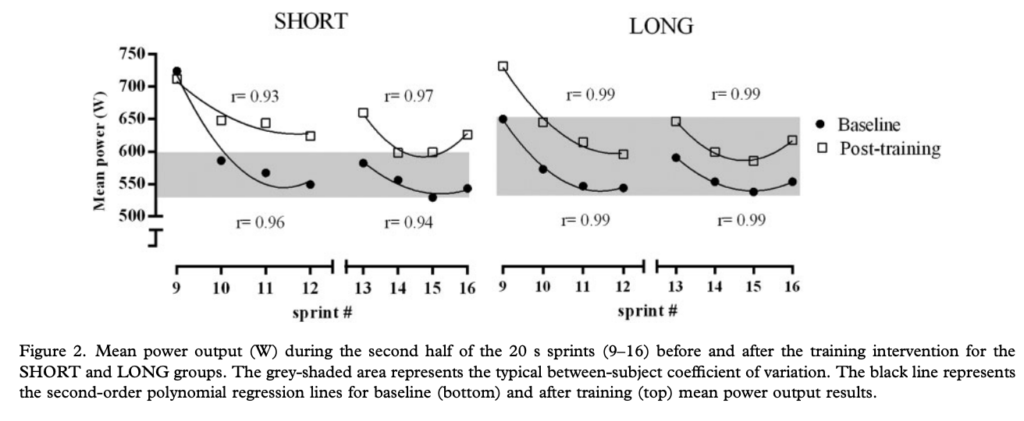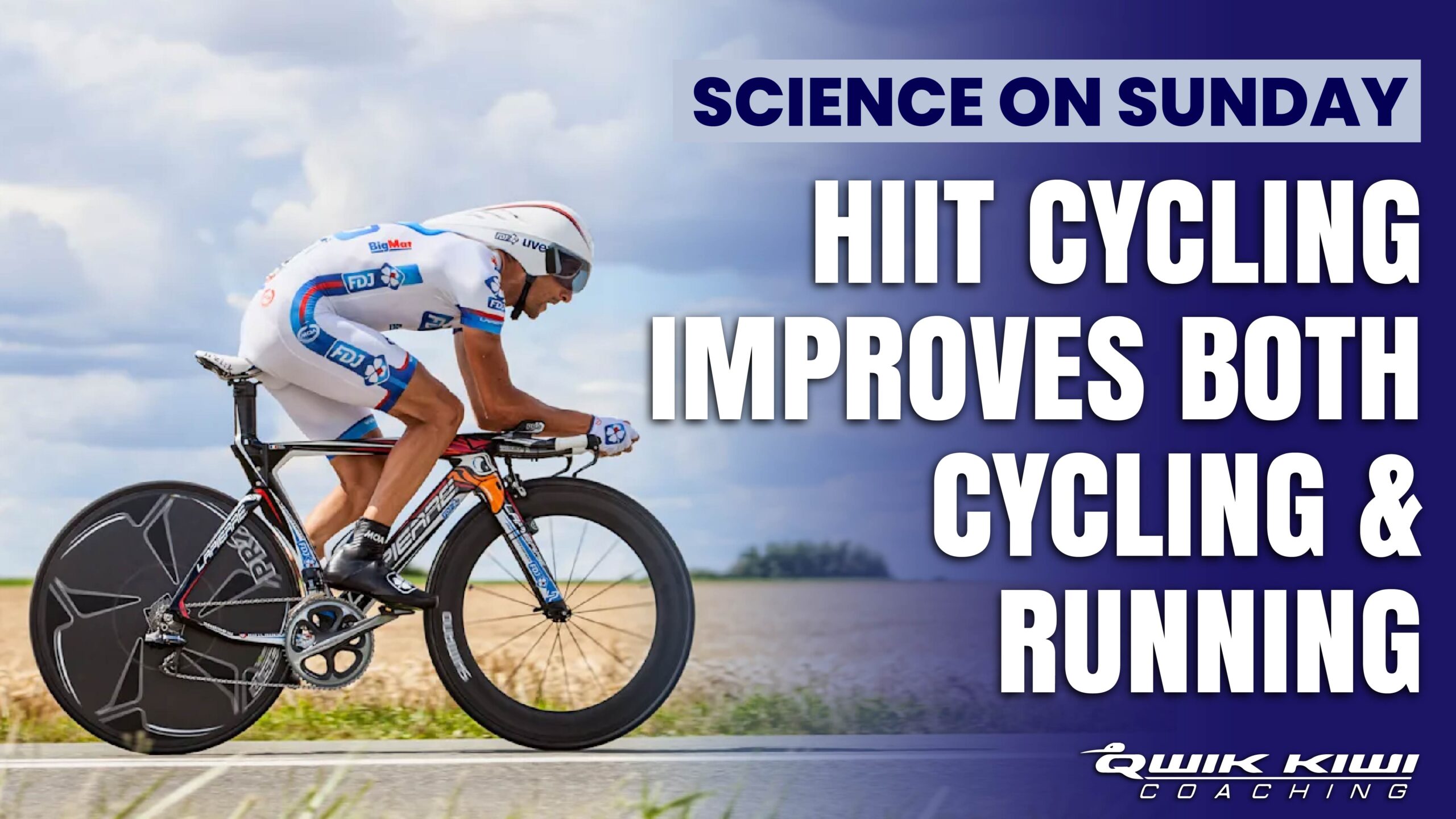Triathlon is a demanding sport to train for across three disciplines. Cross training can provide benefits to the other disciplines, but how much?
Referrence: Etxebarria N; Anson JM; Pyne DB; Ferguson RA; European Journal of Sport Science 2013; 14:6, 521-529
BLUF (Bottom Line Up Front)
Cycle training provides a direct benefit to running performance for triathletes.
Different HIIT interventions can be successful in inducing desirable training adaptations
Brief cycling HIIT programmes should be considered in the lead up to competition to improve performance with minimal training volume
Longer HIIT intervals to maximise both cycling and running training adaptations
Shorter HIIT intervals for athletes seeking improvements in cycling only adaptations
Implementation of HIIT offers specific performance improvements for both cycling and running.
In a race situation, improvements in repeat sprint ability should translate to to an enhanced ability to gain or maintain positions during surges, uphill or technical sections in the latter stages of the cycle section when other competitors might be fatiguing and dropping back in the field
As few as six sessions of short and long HIIT efforts substantially enhance selected physiological and performance measures of triathlon performance such as repeat sprint ability and lower physiological disturbance. Long interval training also improves 5km running ability
Study Design
There were 14 moderately trained male triathletes (VO2max ~58.7) subjects for this study.
After completing a series of three cycle-based & run-based tests where randomly assigned to either:
- HIIT Long (minutes); or
- HIIT Short (seconds) Cycle trained for 3 weeks following allocated sessions then retested.
Considerations
Olympic distance triathlons typically take ~2hrs to complete and the cycle segment takes ~1hr. With drafting and/or multi-lap courses there are higher intensity sprints that now occur within the event the Power profile during the cycle leg is likely to be highly variable. This is different from time-trialing or road racing (which has a massive peak at the end for the sprint). VO2peak is key physiological variable (correlation r=0.86) with Olympic distance triathlon performance
Training Considerations
Due to VO2peak being key variable, training needs to:
- Enhance VO2peak;
- And subsequently maximal power output.
Improved repeat sprint ability can prevent High power outputs deteriorate during latter stages of cycling leg.
Improved maximal aerobic capacity could:
- Aid recovery rate between high-intensity efforts; and/or
- Minimise decay in maximal power during repeated sprints
Training Benefits
Higher VO2peak will translate to lowing the relative intensity of the cycle leg, therefore:
- Allow higher power output during the cycle leg; or
- Benefit the run leg.
As running is negatively impacted by variations in power of preceding cycling the lower relative cycling intensity will give an advantage of starting the run with less relative fatigue.
High-Intensity Interval Training (HIIT)
HIIT has previously proven to:
- Improve physical fitness in less time and with less training volume than traditional training volume.
- Allows athletes to accumulate training time at higher intensities.
5min intervals have shown a:
- ~5% increase in VO2peak
- ~4% increase in maximal power output
Both short and longer intervals have been shown to improve 1hr cycling by ~8%
Hypothesis
Although this wasn’t their hypothesis the researchers looked at whether repeat short (10, 20 and 40 s) interval efforts would yield similar improvements for triathlon compared with the established long 5-min interval format employed in cycling. Consequently, they investigated the effects of six sessions of short and long HIT strategies on both physiological and performance outcomes in cycling and subsequent 5 km running.
Subjects
14 moderately-trained males (2-3 years experience in cycle and run training), who Competed in non-drafting triathlons.
Average:
- Age 33
- Height 1.82cm
- 77.6kg
Testing
The subjects where put through Baseline and Post-Training to measure:
- Maximal Incremental Test
- To determine Maximal Aerobic Power (MAP) and VO2peak
- WU 10min 125W
- Start 150W, increase 5W every 15sec
- To determine Maximal Aerobic Power (MAP) and VO2peak
- Repeat Sprint Ability
- WU 10min 125W
- 4 sets 4x 20sec max (first 2 sets at 150% MAP), 40sec RI (50-75W)
- 3min between 1st and 2nd set, 3rd and 4th set, with 8min between 2nd and 3rd set
- 1hr Variable Power Cycle & 5km Run Time Trial
- Ave power output 65% MAP
- 6x (60sec 60%, 10sec 140%, 70sec 40%, 40sec 110%, 70sec 40%, 90sec 85%, 70sec 40%, 20sec 130%, 70sec 45%, 30sec 120%, 70sec 60%)
- Ave power output 65% MAP
- 5km Road Time Trial
Training Groups
The subjects where pair matched for MAP and body mass. Randomly allocated to either:
- Short high-intensity interval training, or
- Long high-intensity interval training.
Both groups saw their training load increased weekly and they abstained from other high-intensity training.
Short HIIT Group
Week 1
10min WU 125W
3x 10sec near max sprints, ?RI
10sec max, 30sec RI
20sec max, 60sec RI
40sec max, 120sec RI
10sec max, 20sec RI
20sec max, 40sec RI
40sec max, 80sec RI
10sec max, 20sec RI
20sec max, 40sec RI
40sec max, 80sec RI
Week 2
10min WU 125W
3x 10sec near max sprints, ?RI
10sec max, 30sec RI
20sec max, 60sec RI
40sec max, 120sec RI
10sec max, 30sec RI
20sec max, 60sec RI
40sec max, 120sec RI
10sec max, 20sec RI
20sec max, 40sec RI
40sec max, 80sec RI
10sec max, 20sec RI
20sec max, 40sec RI
40sec max, 80sec RI
Week 3
10min WU 125W
3x 10sec near max sprints, ?RI
10sec max, 30sec RI
20sec max, 60sec RI
40sec max, 120sec RI
10sec max, 30sec RI
20sec max, 60sec RI
40sec max, 120sec RI
10sec max, 20sec RI
20sec max, 40sec RI
30sec max, 60sec RI
10sec max, 20sec RI
20sec max, 40sec RI
40sec max, 80sec RI
10sec max, 20sec RI
20sec max, 40sec RI
40sec max, 80sec RI
Long HIIT Group
Week 1
10min WU 125W
3x 45sec sustained effort, ?RI
6x 5min 80% VO2peak 1min RI
Week 2
10min WU 125W
3x 45sec sustained effort, ?RI
7x 5min 80% VO2peak 1min RI
Week 3
10min WU 125W
3x 45sec sustained effort, ?RI
8x 5min 80% VO2peak 1min RI
Training Interventions
Short HIIT
Improved 21% in 10sec Sprint (ave 621->757W)
No change in 20sec or 40sec Efforts (485W & 435W respectively)
Long HIIT
No change in 5min Power (ave 283/283/286W)
Outcome Measures – Short HIIT
| Baseline | Post-training | Change | |
| VO2peak | 4.53 L.min-1 | 4.85 L.min-1 | 7.3% (small) |
| MAP | 393 W | 405W | 3.1% (small) |
| Mean Power (sprints 9-16) | 579W | 639W | 10.3% (moderate) |
| Peak Power | 773W | 834W | 8.0% (small) |
| 2.5km Split | 11:02 | 10:39 | 3.0% (small) |
| 5km Run Time | 21:35 | 20:55 | 2.8% (trivial) |
Outcome Measures – Long HIIT
| Baseline | Post-training | Change | |
| VO2peak | 4.47 L.min-1 | 4.78 L.min-1 | 7.5% (small) |
| MAP | 393W | 415W | 5.8% (small) |
| Mean Power (sprints 9-16) | 568W | 629W | 10.7% (small) |
| Peak Power | 772W | 838W | 8.5% (small) |
| 2.5km Split | 10:52 | 10:10 | 6.3% (small) |
| 5km Run Time | 21:25 | 20:21 | 4.9% (small) |
Results Maximal Incremental Test
Both groups similar small increase in VO2peak ~7%
Both groups similar small increase in MAP ~3-6%
Results Repeat Sprint Ability
Both groups similar small increase in mean power output for the final 8 sprints ~10%
Both groups similar small increase in peak power output for the final 8 sprints ~8%
Improvement in Mean Power Output During the Last 8 Sprints

Results 1hr Variable Power Cycle
- Mean Power was 256W for Short HIIT for both Baseline & Post-Training
- Mean Power was 255W for Long HIIT for both Baseline & Post-Training
- BLa and HR levels were moderately lower at 40min & 60min for Short HIIT
- BLa and HR levels were moderately lower at 20min, 40min & 60min for Long HIIT
- RPE levels were moderately lower at 60min for Short HIIT
- RPE levels were moderately lower at 20min, 40min & 60min for Long HIIT
BLa, HR & RPE at 20, 40 & 60min of the 1 Hour Variable Power Cycle

Results 5km Run Time Trial
The Long HIIT group showed a substantial 42sec improvement at 2½km split and a 64sec improvement for the 5km.
The Short HIIT group showed a trivial improvement and there was an unclear difference between the groups in 5km run time.
The unclear result is due to individual variations in results, the implication of this was that the less-fit runners recorded larger improvement.
Discussion – Overview
The study demonstrated that 3 weeks of HIIT training of either long or short cycle intervals induced small to moderate improvements in:
- VO2peak
- Cycling MAP
- Maximal repeat sprint ability
Longer interval training (5min efforts) improved 5km run time (after 60min variable power cycle) by 64 seconds.
Bare in mind that only low intensity and low volume of run training was conducted by both groups.
Discussion – 5km Run TT
Both groups had a similar baseline run time (±SD).
The substantial improvement of the Long intervention can be attributed to the training intervention.
A cross training effect cycling and running allows triathletes to gain physiological capacities often comparable to those achieved in individual sports:
- At the same HR, cardiac output is lower in cycling compared to due to a lower stroke volume.
- Therefore, for central adaptations to transfer to running in response to cycle training the cycling intensity needs to be near maximal
Discussion – 60min Variable Power Cycle
A small to moderately lower perceptual and physiological response during 1hr variable power cycle was measured. This was presumed to be related to an increase in Maximal Aerobic Capacity. Consequently the relative intensity of the post-training test was then lower.
Short duration sprints use highly anaerobic (phosphocreatine and glycolytic) pathways for energy. However, contribution of aerobic energy increases greatly as the number of sprints increases.
Discussion – Repeat Sprint Ability
The increase in Maximal Aerobic Capacity presumably influenced the improvement in repeat sprint ability by aiding phosphocreatine resynthesis between repeated sprints. While longer high-intensity intervals increase intercellular buffering capacity, as well as lactate and H+ removal which can explain improved repeat sprint ability.
